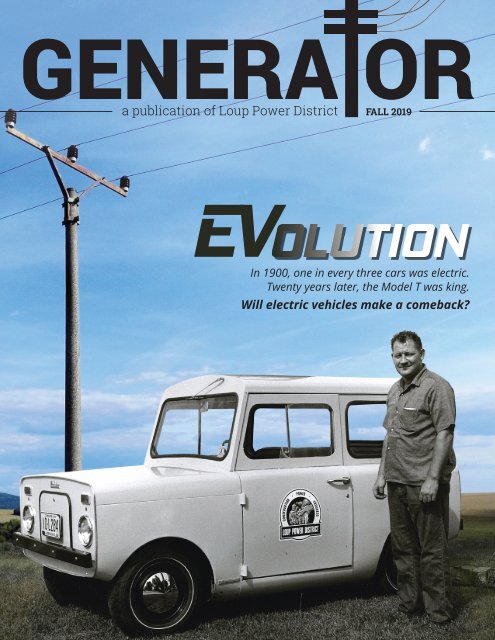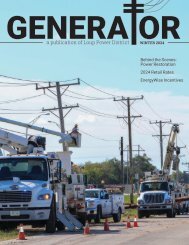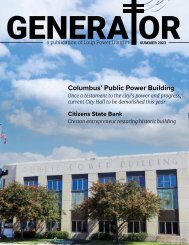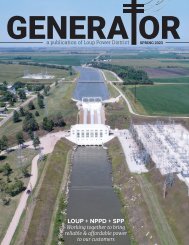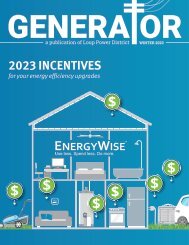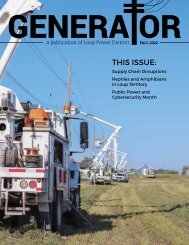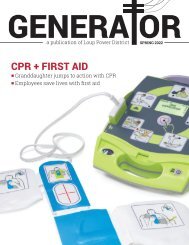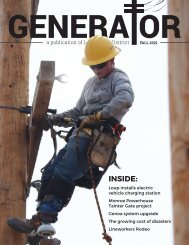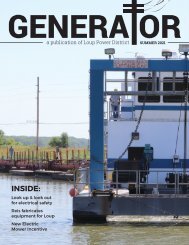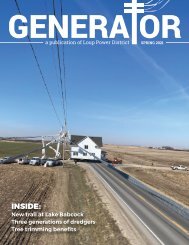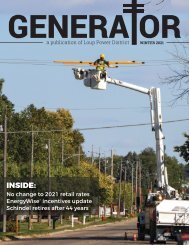Generator - Fall 2019
- No tags were found...
You also want an ePaper? Increase the reach of your titles
YUMPU automatically turns print PDFs into web optimized ePapers that Google loves.
GENERA OR<br />
a publication of Loup Power District FALL <strong>2019</strong><br />
EVIn 1900, one in every three cars was electric.<br />
Twenty years later, the Model T was king.<br />
Will electric vehicles make a comeback?
BOARD<br />
OF DIRECTORS<br />
Larry Zach<br />
Chairman<br />
Chris Langemeier<br />
First Vice Chairman<br />
Ross Knott<br />
Second Vice Chairman<br />
Alan Drozd<br />
Secretary<br />
Dick Tooley<br />
Treasurer<br />
Rich Aerni<br />
Robert Cerv<br />
Jim Donoghue<br />
Mike Fleming<br />
Steve Heesacker<br />
EXECUTIVE STAFF<br />
Neal Suess<br />
President/ CEO<br />
PUBLIC POWER MONTH<br />
DID YOU<br />
? KNOW<br />
Nebraska is the only state in the nation<br />
served entirely by public power electric utilities.<br />
Community-owned utilities mean that<br />
Nebraskans are working for Nebraskans.<br />
Public power electric utilities<br />
are not-for-profit, meaning<br />
there’s no profit motive and<br />
no shareholder pockets to<br />
pad — simply affordable,<br />
cost-of-service electric rates<br />
for consumers.<br />
Walt Williams<br />
Vice President,<br />
Administrative Services/CFO<br />
David Bell<br />
Vice President,<br />
Development/Marketing<br />
Ron Ziola<br />
Vice President, Engineering<br />
Dan Hellbusch<br />
Vice President, Operations<br />
The Loup <strong>Generator</strong> is<br />
published quarterly as a<br />
service for Loup employees,<br />
families, friends and<br />
associates.<br />
For feedback, story ideas<br />
and submissions, contact:<br />
Stacy Wemhoff<br />
Communications Coordinator<br />
402-562-5711<br />
swemhoff@loup.com<br />
Nebraska’s electric utilities are governed<br />
by locally elected or appointed boards and<br />
councils. This means you have a voice in the<br />
decisions made by your local utility.<br />
Nebraska’s electric utilities use a diverse<br />
mix of fuel resources to generate electricity,<br />
such as wind, water, coal, nuclear, natural<br />
gas, solar and methane.<br />
Nebraska’s electric utilities pay more than<br />
$100 million<br />
to communities they serve<br />
each year in lieu of taxes.<br />
Those dollars stay local,<br />
helping to empower our<br />
hometowns.<br />
Each dollar of a public<br />
power employee’s<br />
paycheck circulates<br />
through the local economy<br />
an estimated four to five<br />
times.<br />
KEEPING<br />
LOCAL DOLLARS<br />
LOCAL.<br />
2 GENERATOR
PRESIDENT'S MESSAGE<br />
Loup welcomes Todd Duren<br />
As I have mentioned on several occasions before, there are many new faces<br />
showing up at Loup Power District. This is mostly a result of ongoing retirements<br />
at the District — we are not immune to the retirements that are affecting the entire<br />
utility industry.<br />
Retirements create an opportunity to bring in new people with fresh ideas about a<br />
variety of issues that will enhance the District into the future.<br />
One of these new faces that you will begin to see is the District’s new Vice President<br />
of Corporate Services, Todd Duren. Todd comes to Loup from Nebraska Public Power<br />
District where he worked in the Columbus office. Before that, he worked for Columbus<br />
Hydraulics for many years. Additionally, Todd used to work for Loup Power District<br />
during the summers when he was in school, so we were able to bring Todd back to his<br />
roots.<br />
The Vice President of Corporate Services position is a new position to the District,<br />
which was created as we combined Economic Development and Marketing, Human<br />
Resources, Safety and Training and Information Technology into a single department.<br />
Part of this was necessitated as a result of retirements in the current Economic<br />
Development and Marketing Department.<br />
Todd brings to the District a lot of business knowledge which will be helpful in<br />
moving the District forward with this always-changing industry. His background and<br />
knowledge as an industrial customer, will improve the District’s ability to respond to<br />
the needs of all of our customers as he understands how businesses think and react to<br />
changes in the electric utility industry.<br />
While spending the last year at NPPD, Todd has been on the forefront of issues<br />
regarding electric vehicles. Electric vehicles present a huge opportunity for load<br />
growth within the industry and many states and utilities are looking at adding<br />
charging stations and other infrastructure improvements to assist in promoting the<br />
sale and use of these vehicles.<br />
In addition, as a lifelong resident of the Columbus area, Todd has an intimate<br />
knowledge of Columbus and how the City and surrounding area have grown over the<br />
years. This knowledge helps him connect with customers and industry looking for a<br />
home in Columbus and what the City can offer to provide benefits to these customers.<br />
Once again, we are excited to introduce Todd as one of the newest members of Loup<br />
Power District and we look forward to him interacting with you and getting to know<br />
you better.<br />
Welcome aboard, Todd!<br />
by NEAL SUESS<br />
President/CEO<br />
TODD DUREN<br />
Vice President<br />
of Corporate Services<br />
FALL <strong>2019</strong> 3
Powering Up After an Outage<br />
When the power goes out, we expect it to be restored within a few hours.<br />
But when a major storm or natural disaster causes widespread damage,<br />
extended outages may result. Our line crews work long, hard hours to restore<br />
service safely to the greatest number of members in the shortest time<br />
possible. Here’s how we get to work when you find yourself in the dark:<br />
2<br />
3<br />
5<br />
4<br />
4 GENERATOR
1. High-Voltage Transmission Lines:<br />
Transmission towers and cables supply power to<br />
transmission substations (and thousands of customers),<br />
and they rarely fail. But when damaged, these facilities<br />
must be repaired before other parts of the system can<br />
operate.<br />
2. Distribution Substation:<br />
A substation can serve hundreds or thousands of<br />
customers. When a major outage occurs, our line crews<br />
inspect substations to determine if problems stem from<br />
transmission lines feeding into the substation, the<br />
substation itself or if problems exist further down the line.<br />
3. Main Distribution Lines:<br />
If the problem cannot be isolated at a distribution<br />
substation, distribution lines are checked. These lines carry<br />
power to large groups of customers in our communities.<br />
4. Tap Lines:<br />
If local outages persist, supply lines (also known as tap<br />
lines) are inspected. These lines deliver power to<br />
transformers, either mounted on poles or placed on pads<br />
for underground service, outside businesses, schools and<br />
homes.<br />
5. Service Lines:<br />
If your home remains without power, please be patient —<br />
the service line between a transformer and your residence<br />
may need to be repaired. If you experience an outage,<br />
please give us a call so we can isolate the issue and fix it.<br />
FALL <strong>2019</strong> 5
strategies for slaying your<br />
ENERGY<br />
VAMPIRES<br />
Halloween is just around the corner. There could be a hidden terror<br />
lurking in your home. We’re talking about energy vampires —<br />
evil ghouls that suck electrical power from your appliances when<br />
you aren’t using them, taking a big bite out of your wallet<br />
Unplug!<br />
Unplug!<br />
Unplug!<br />
Unplug devices or appliances<br />
you don’t use often and those that<br />
are easy to reach as you’re heading<br />
out the door.<br />
Coffee makers only use 1–3 watts<br />
when off, but add that to your<br />
microwave, small kitchen television,<br />
toaster oven, and other unused<br />
appliances and you could save<br />
$10-20 per year just in the kitchen!<br />
Don’t forget cell phone and tablet<br />
chargers, hair dryers,<br />
and space heaters.<br />
Use Power Strips<br />
Power strips let you toggle the power flow on and off. This<br />
means you can control the power usage of clusters of devices<br />
so that they’re not consuming electricity when you’re not at<br />
home. Using a light switch that turns power outlets on and off,<br />
if you have one, accomplishes the same end with even<br />
less effort.<br />
An advanced power strip makes it even easier by turning off<br />
idle electronics without any additional steps from you.<br />
One of the easiest places to use a power<br />
strip is your entertainment center. Older<br />
set-top cable boxes and DVRs in your living<br />
room are some of the most frightening<br />
energy vampires, as they’re less efficient<br />
than newer models. Some of these devices<br />
are constantly draining 25-45 watts of<br />
energy when off.<br />
Curb Idle Time<br />
Set your computer to sleep mode or power it down<br />
when you’re not using it. Do the same with your<br />
video game console instead of leaving it paused for<br />
a prolonged period of time.<br />
Energy vampires throughout<br />
your home could add an extra<br />
10 percent to your monthly<br />
electricity bill.<br />
Take a few minutes to<br />
find them and banish<br />
them for good!<br />
Visit EnergySaver.gov<br />
for more tricks to save<br />
energy and money.<br />
Make Smart Upgrades<br />
When it comes time to send your old electronics and<br />
appliances to the graveyard, consider replacing them<br />
with ENERGY STAR devices.<br />
They have a lower standby consumption than your<br />
average device and use less energy all around.<br />
6
U.S. HEATING DEGREE DAYS<br />
Heating degree days measure how cool the outdoor temperature was on a given day or during a period<br />
of days. The map below shows measurements of U.S. heating degree days in 2018 by census region.<br />
Extreme outdoor temperatures bring a higher number of degree days, which results in higher energy use.<br />
WASH.<br />
ORE.<br />
IDAHO<br />
NEV.<br />
MONT.<br />
WYO.<br />
West North Central:<br />
6,973 HDD<br />
N.D.<br />
S.D<br />
NEB.<br />
MINN.<br />
IOWA<br />
WIS.<br />
East North<br />
Central:<br />
6,433 HDD<br />
ILL.<br />
MICH<br />
IND.<br />
OHIO<br />
Middle<br />
Atlantic:<br />
5,780<br />
HDD<br />
PA.<br />
N.Y.<br />
VT.<br />
N.J.<br />
ME.<br />
N.H.<br />
MASS.<br />
R.I.<br />
CONN.<br />
New<br />
England:<br />
6,330HDD<br />
CALIF.<br />
UTAH<br />
COLO.<br />
KAN.<br />
MO.<br />
KY.<br />
WV.<br />
VA.<br />
DEL.<br />
MD.<br />
Pacific:<br />
3,161 HDD<br />
ARIZ.<br />
N.M.<br />
OKLA.<br />
ARK.<br />
MISS.<br />
TENN.<br />
ALA.<br />
GA.<br />
S.C.<br />
N.C.<br />
Mountain:<br />
4,808 HDD<br />
TEXAS<br />
L.A.<br />
FLA.<br />
South Atlantic:<br />
2,629 HDD<br />
*HDD represents heating degree days<br />
Source: Energy Information Administration<br />
West South<br />
Central:<br />
2,247 HDD<br />
East South<br />
Central:<br />
3,480 HDD<br />
Weather can have a major impact on energy bills, and<br />
when the outdoor temperatures become extreme, your<br />
heating and cooling equipment works harder to keep<br />
your home comfortable.<br />
Here at Loup, we use degree days to anticipate heating<br />
and cooling needs for our customers.<br />
Never heard of a degree day? Don’t worry, you’re not<br />
alone. Let’s take a look at what degree days are and why<br />
they’re important for electric utilities.<br />
Degree days measure how cold or warm a location<br />
is by comparing the average of the high and low<br />
(mean) of the outdoor temperatures recorded in that<br />
location to the standard U.S. temperature of 65 °F. The<br />
assumption is that we don’t need heating or cooling to<br />
be comfortable when this is the outdoor temperature.<br />
Cooling Degree Days (CDD) is the equivalent number<br />
of days you would have to cool your building by one<br />
degree to accommodate the cooling requirement.<br />
Similarly, Heating Degree Days (HDD) work the same<br />
except with heat. For example, a day that is 55°F<br />
degrees is worth 10 Heating Degree Days because it is<br />
10 degrees below 65°F. HDD is calculated in this way for<br />
each day of the year and summed up to get the total<br />
annual HDD.<br />
So, the more extreme the outdoor temperatures, the<br />
higher the number of degree days. And the higher<br />
the number of degree days, the higher the amount of<br />
energy used for space heating and cooling.<br />
Variations in electric bills often follow closely with<br />
degree days. That’s why electric utilities use this data to<br />
anticipate future energy demand.<br />
In Columbus, there were 7,041 heating degree days and<br />
913 cooling degree days from July 1, 2018, through June<br />
30, <strong>2019</strong>.<br />
Heating degree days will start to rise as we head toward<br />
fall and winter. Here are some tips to help you reduce<br />
your energy use.<br />
• Set your thermostat as high as comfortably possible.<br />
The smaller the difference between the indoor and<br />
outdoor temperatures, the lower your cooling costs<br />
will be. The Department of Energy recommends<br />
setting your thermostat to 78° F when you’re home<br />
and a higher setting for when you’re away.<br />
• Turn off ceiling fans when you leave a room.<br />
• Close window coverings, like curtains and blinds,<br />
during the day to block sunlight.<br />
• Use caulk and weather stripping to seal air leaks<br />
around doors and windows.<br />
Visit loup.com for more energy tips and information<br />
about our EnergyWise℠ incentives and rebates that<br />
help you make energy-efficient home improvements.<br />
FALL <strong>2019</strong> 7
the evolution<br />
of the<br />
The appeal of electric vehicles is<br />
gaining momentum. The push<br />
for greater mileage in terms of<br />
MPG that began in the second half of the<br />
last century has been joined by the push for<br />
greater miles per charge.<br />
But electric vehicles are far from a modern<br />
invention. The first known electric car was<br />
developed in 1837 in Aberdeen, Scotland.<br />
Early variants were powered by galvanic cells<br />
rather than rechargeable<br />
batteries. The lead-acid<br />
battery was invented in<br />
France in 1859 with further<br />
French development<br />
leading to manufacturing<br />
of these batteries on an<br />
industrial scale in the<br />
early 1880s. This allowed a<br />
rechargeable battery to be<br />
installed on the vehicle.<br />
Soon manufacturers were<br />
selling a wide array of EVs<br />
ranging from trams to<br />
trolleys, to cars, and even<br />
locomotives. Interest in<br />
electric cars blossomed<br />
in the late 1890s and<br />
early 1900s. As roads<br />
improved and became<br />
more extensive, demand for greater range<br />
emerged. A variety of solutions were put<br />
forth including the first battery exchanges by<br />
an electric utility in Connecticut in 1910 and<br />
the first hybrid automobile in 1911. It would<br />
not be long until America led the world in<br />
number of EVs on the roads.<br />
But the rapid expansion of the country and<br />
the limitation of electricity to major cities and<br />
towns spelled the end of the electric car. The<br />
world wanted to be mobile and EVs simply<br />
did not have the range required. Enter Henry<br />
Ford and the mass-produced, affordable<br />
internal combustion engine, and the EV’s fate<br />
was sealed — but not forever.<br />
Today, electricity is readily available, unlike<br />
those early days of the EV. Most roads are<br />
paved and environmental concerns are<br />
increasing awareness of these cars.<br />
While many drawbacks of EVs are gone, there<br />
is still a major concern limiting EV growth<br />
dubbed “range anxiety.” This stems from the<br />
persistent limited range of all EVs. While the<br />
Tesla offering provides 270 miles for their<br />
all-wheel drive model and 355 miles on their<br />
standard models, that pales in comparison<br />
to most internal combustion cars. The lack of<br />
a rapid charging infrastructure is an ongoing<br />
impediment. Just like their 20th century<br />
predecessors, pure EVs are great “city cars.”<br />
Fortunately, advances in battery technology<br />
are hammering away at the range issue.<br />
Range is steadily expanding and battery<br />
management systems are squeezing<br />
out more miles. At the same time, more<br />
companies and utilities are installing efficient<br />
charging stations at their places of business<br />
and in popular public locations.<br />
Aside from range anxiety, EVs have a bright<br />
future. Prices are dropping and range is<br />
expanding so owners can confidently drive<br />
nearly everywhere with a little bit of planning.<br />
— Continued on page 10<br />
8 GENERATOR
ALL ABOUT EVS<br />
HOW DO I CHARGE IT?<br />
Your electric vehicle comes with everything you<br />
need to plug it in and fuel up. The majority of<br />
electric vehicle owners charge their cars<br />
at home overnight, when electricity<br />
prices are lower. EVs can be charged<br />
on a standard 120V wall<br />
outlet, also called Level 1<br />
charging. Faster charging ( about<br />
4–5 hours) can be achieved at<br />
home or the workplace with Level 2 charging.<br />
Level 3 chargers take about an hour and are<br />
typically located at public charging stations.<br />
CAN I GET WHERE<br />
I NEED TO GO?<br />
The average American’s daily commute is less<br />
than 30 miles and most electric vehicles<br />
have a range of more than 70 miles.<br />
It’s a reliable way to get from point A<br />
to point B. With growing<br />
electric vehicle charging<br />
infrastructure, you can<br />
also charge along the way. Plugin<br />
hybrids, like the Toyota Prius,<br />
can also run on battery power or<br />
gasoline.<br />
Sources: U.S. Department of Energy, PlugShare, Electrification<br />
Coalition, and Plug In America, AAA, and publicpowered.com.<br />
Graphic by American Public Power Association.<br />
e<br />
e<br />
e<br />
WHY GO ELECTRIC?<br />
Driving an EV can<br />
cost 70 percent<br />
less than a gaspowered<br />
vehicle. If<br />
you pay $0.11 per kWh for electricity and<br />
have an EV rated at 34 kWh per 100 miles,<br />
the cost is about $0.04 per mile. If gas is<br />
$3 per gallon and a gas-powered<br />
vehicle gets 25 mpg, the cost is<br />
about $0.12 per mile. Electric<br />
vehicle owners are also eligible<br />
for federal and state tax credits.<br />
Electric cars are also more efficient — up<br />
to 80 percent of the charge is transferred<br />
directly to powering the car, compared to<br />
14-26 percent with gas-powered vehicles.<br />
WILL THIS CHANGE MY<br />
ELECTRIC BILL?<br />
The average electric vehicle needs 30<br />
kilowatt-hours for a 100-mile charge. At<br />
an average electricity rate of 12 cents-perkilowatt-hour<br />
it can cost about<br />
$540 per year to charge your<br />
car, compared to an average<br />
of $2,000 to fuel a gas-powered<br />
car. Charging during peak<br />
times could hike your electricity bill, so ask<br />
your utility what the best time is to charge.<br />
WHERE CAN I CHARGE<br />
ON THE GO?<br />
There are more than 30,000 EV<br />
“fueling” stations in the United<br />
States. Need to find a plug? Visit<br />
publicpowered.com or PlugShare.<br />
com for interactive maps.<br />
FALL <strong>2019</strong> 9
50 YEARS AGO: Loup EV on display at state fair<br />
The Nebraska Centennial State Fair<br />
is the destination of the Loup Power<br />
District’s electric car. The car will<br />
be on display at the booth of the<br />
Nebraska Inter-Industry Electric Council<br />
throughout the entire fair which begins<br />
August 29.<br />
“The car is always a big attraction<br />
at the many county fairs and other<br />
events where Loup has had the car on<br />
display,” according to Don Daniels, Loup<br />
spokesman from Columbus and the<br />
electric car’s “master.”<br />
Some of the recent fairs and events<br />
include the Boone, Platte and Burt<br />
County Fairs, the University of<br />
Nebraska’s 18th annual Tractor Power<br />
and Safety Day held in July, and the<br />
Colfax County Fair parade.<br />
The two-seater car was manufactured<br />
by Westinghouse Corporation and<br />
is named “Marketeer I.” It is used<br />
extensively by the Loup Power<br />
District to provide Westinghouse<br />
with maintenance and operation cost<br />
data. Loup servicemen also drive the<br />
car during their regular work days to<br />
read meters and make service calls<br />
throughout towns located in Boone,<br />
Colfax, Nance and Platte counties, the<br />
four-county area served by Loup Power<br />
District.<br />
Low operating cost is the major<br />
advantage of an electric car. An<br />
operation cost comparison for 1,000<br />
miles made with a conventional car<br />
shows that it costs $22.40 on the<br />
average to operate a gasoline enginepowered<br />
car for 1,000 miles or 2.24<br />
Former Loup employee Don Daniels with Loup’s EV, the Marketeer I, in 1969.<br />
cents per mile. By comparison, the<br />
electric car costs $10.40, or 1.04 cents<br />
per mile.<br />
Power for “Marketeer I” comes from 12<br />
six-volt batteries that supply current<br />
to two 36-volt electric motors each<br />
independently driving a rear wheel<br />
of the vehicle. The 2,400-pound car is<br />
capable of traveling five miles between<br />
charges at speeds of up to 30 miles per<br />
hour.<br />
Batteries can be recharged<br />
approximately 600 times with any<br />
normal 110-volt wall outlet in the home<br />
or garage. This results in 30,000 miles<br />
per set of batteries. A full recharge<br />
generally requires about eight hours and<br />
would normally be done overnight.<br />
The electric car is under major<br />
consideration as one of the solutions to<br />
the problem of air pollution because it<br />
has no exhaust fumes. Other significant<br />
features include quite operation, instant<br />
starting, low-cost maintenance, and<br />
dependable year-round operation.<br />
— from the Columbus Telegram,<br />
August 28, 1969<br />
— Continued from page 8<br />
TOP 5 EVs in US —<br />
FIRST HALF OF <strong>2019</strong><br />
1. Tesla Model 3 — 81,100<br />
2. Toyota Prius Prime — 10,480<br />
3. Tesla Model x — 10,225<br />
4. Chevrolet Bolt — 9,266<br />
5. Tesla Model S — 8,200<br />
Source: insideevs.com<br />
Driving an EV is quite different than a traditional vehicle. While an internal<br />
combustion engine must rev up to speed, an EV has full power at its disposal<br />
instantly. Of course, there are limits on this 0-60 mph capability to prevent<br />
inexperienced and over-eager drivers from launching themselves into accidents and<br />
speeding tickets. They are quiet and well-equipped inside and allow you to forever<br />
bypass the lines at the gas station––unless you are in need of some snacks and a<br />
slushy.<br />
If you do purchase an EV, be sure to let Loup Power District or your local utility know.<br />
The service to your home is sized to meet the demands of your house as they existed<br />
when service was connected. Adding the EV charger creates a risk of overloading the<br />
wires and transformers powering your home. Overloaded services can fail and leave<br />
you in the dark with an uncharged EV.<br />
Someday, we’ll all be gliding silently––and cleanly––on our travels.<br />
10 GENERATOR
Incentives reduce EV costs<br />
The upfront cost of electric vehicles (EVs) is considered the main obstacle to potential consumers.<br />
As an incentive, Loup Power District, Nebraska Public Power District (NPPD), and the Nebraska Environmental Trust (NET) have<br />
partnered to create programs that help reduce the purchase price of EVs.<br />
In addition to these programs, government tax credits of up to $7,500 are available on select electric vehicles.<br />
$4,500 | EV & CHARGER<br />
$500 | CHARGING STATION $100 | PRE-WIRING<br />
$4,000 incentive for the purchase or<br />
lease of a new battery electric vehicle<br />
$500 incentive for the installation<br />
of a residential ChargePoint 32-amp,<br />
WI-FI-enabled vehicle charging station<br />
(Charging station must also be purchased<br />
and installed to receive the $4,000<br />
vehicle incentive)<br />
• Visit with your electrical utility to discuss your EV and<br />
charging needs. Pick up an application form and ensure<br />
incentives are still available.<br />
• All three programs will require a reservation request<br />
prior to purchase and/or installation.<br />
• Reservations have a limited time to purchase and/or<br />
install.<br />
• Once approved, there will be a time period to provide<br />
proof of purchase or installation.<br />
$500 incentive for the installation<br />
of a residential ChargePoint 32-amp,<br />
WI-FI-enabled vehicle charging station<br />
QUALIFICATIONS:<br />
$100 incentive for in home pre-wiring<br />
for the future installation of an electric<br />
vehicle charging station<br />
• Submit payment request after purchase and<br />
installation.<br />
• Charger installation location and vehicle registration<br />
must be the same location and be a single or multifamily<br />
residential location and have internet wireless<br />
connectivity to qualify.<br />
• Incentives are limited so check with your local public<br />
power utility for availability.<br />
EV FEATURES:<br />
EASY to maintain: EVs have 20 moving parts instead of 2,000. This makes repairs easy. Many models have regenerative braking.<br />
LIMITLESS models: Ford expects to showcase 40 new models by 2022. GM anticipates releasing 20 models by 2023.<br />
ENVIRONMENTALLY FRIENDLY: Zero emissions mean you can feel great about doing your part to protect the earth.<br />
COST EFFECTIVE: Charging your EV is equal to buying gas for 75¢/gallon. Battery prices are also dropping.<br />
TECH-SAVVY features: EVs offer enhanced safety options. You can even charge your EV from a mobile app!<br />
RESPONSIVE: Excellent torque, yet quiet as a whisper!<br />
INCENTIVES: NPPD has three great incentives with more to come!<br />
CHARGE from home: Charge your EV at home every night with Level I or Level II charging.<br />
Source: NPPD<br />
FALL <strong>2019</strong> 11
employee notes<br />
TODD DUREN<br />
Vice President of Corporate Services<br />
Welcome<br />
Todd Duren of Columbus joined Loup Power District as Vice President of Corporate<br />
Services in August.<br />
In this role, Duren is responsible for oversight of four District departments —<br />
Development/Marketing, Information Technology, Human Resources, and Safety. He<br />
will oversee regulatory compliance in the HR and safety areas and provide leadership on<br />
economic development and public relations projects.<br />
Duren was previously employed as Sustainable Strategies Consultant for Nebraska<br />
Public Power District. Prior to NPPD, Todd also worked for Columbus Hydraulics Company<br />
for 23 years, serving in various management positions including Vice President of Sales<br />
and Plant Operations and Company President. He worked for Loup Power District during<br />
the summers of 1987 and 1988 on the canal maintenance crew.<br />
Duren is a graduate of Scotus Central Catholic High School. He earned a degree in Civil<br />
Engineering from the University of Nebraska-Lincoln. He and his wife, Lisa, have three<br />
children — Anthony, 28, and his wife, Blair; Morgan, 26; and Jared, 22.<br />
In his free time, Duren enjoys hunting, cheering on the Huskers, and playing and<br />
watching sports.<br />
20 years<br />
TONY DUBAS<br />
Journeyman Lineman<br />
Tony Dubas of Fullerton joined Loup in 1999<br />
as a Lineman in the Fullerton retail operation.<br />
He was promoted to Journeyman Lineman in<br />
2005.<br />
As a Journeyman Lineman, Dubas is a<br />
member of the crew that is responsible for the<br />
construction, operation, and maintenance of<br />
electric transmission and distribution systems<br />
and substations in the Fullerton Division.<br />
Dubas is a graduate of Fullerton High<br />
School. He earned an Associate of Applied<br />
Science Degree in Utility Line from Northeast<br />
Community College in Norfolk.<br />
Dubas and his wife, Jennifer, are the parents<br />
of four children: TJ, Fletcher, Cael, and Charli.<br />
5 years<br />
SHARI CROMWELL<br />
Lead Customer<br />
Service Representative<br />
Shari Cromwell of Columbus joined Loup<br />
in 2014 as Customer Service Representative at<br />
the Columbus General Office.<br />
In 2017, she was promoted to Lead<br />
Customer Service Representative.<br />
Her responsibilities include organizing the<br />
daily activity of the Customer Service Reps at<br />
the Columbus General Office. This includes<br />
procedures and system operations scheduling,<br />
payment processing and service orders, and<br />
balancing of accounts.<br />
Cromwell is a graduate of Monroe High<br />
School. She and her husband, John, Jr., are the<br />
parents of two sons — Austin and Aiden.<br />
12 GENERATOR
KEITH SHONKA<br />
Meter Relay & Equip Tech Sr<br />
Keith Shonka joined Loup in 1989 as Second Assistant Plant Operator at the Columbus<br />
Powerhouse. He was promoted to First Assistant Plant Operator in 1990 and Plant Operator<br />
in 1991. He transferred to Meter Relay and Equipment Technician I in the Meter and<br />
Maintenance Department at the Columbus Service Center in 1994. He was promoted to<br />
Meter Relay and Equipment Technician Senior in January.<br />
Shonka is on the team that is responsible for installation and maintenance of substation<br />
power equipment. The team’s duties include operating equipment that switches electric<br />
power between substations and transmission lines, relay maintenance and testing, and<br />
designing substation control wiring.<br />
Shonka is a native of Surprise and a graduate of David City Aquinas High School. He holds<br />
an Associate of Applied Science Degree in Electrical Technology from Southeast Community<br />
College in Milford.<br />
He and his wife, Karen, are the parents of four children: Jacob, Katie, Nicolas, and<br />
Benjamin.<br />
30 Years<br />
1 Year<br />
MICHAEL LANGE<br />
Lineman<br />
Michael Lange of Columbus joined Loup Power<br />
District as a Lineman in 2018.<br />
Lange is a member of the crew that is responsible<br />
for the construction, operation and maintenance of<br />
electric transmission and distribution systems in the<br />
Columbus area.<br />
He is a graduate of Columbus High School and<br />
earned a Utility Line degree from Metropolitan<br />
Community College.<br />
20 Years<br />
ANDY ZAREK<br />
Headgates Operator<br />
Andy Zarek of Genoa joined Loup in 1999 as a<br />
Maintenance Man at the Genoa Headworks. He was<br />
promoted to Equipment Operator in 2005 and was<br />
named Dredge Operator in 2015.<br />
In 2016, Zarek was promoted to his current position<br />
of Headgates Operator. His primary duty is to regulate<br />
the flow of the Loup River into the Loup Power canal<br />
at the Genoa Headworks. He is also responsible for<br />
operating the gates as well as keeping them free of<br />
ice and debris. He also oversees and assists in the<br />
maintenance of the Headworks area.<br />
Zarek is a graduate of Genoa High School. He studied<br />
Machine Tool Technology at Central Community<br />
College.<br />
Zarek and his wife, Nicole, are the parents of two<br />
children, Keaton and Tayla.<br />
FALL <strong>2019</strong> 13
around the District<br />
HACKBERRY TREE TROUBLE<br />
There was a lot of work to do near 26th Avenue and<br />
16th Street in Columbus in July.<br />
A large hackberry tree fell on lines there, snapping off<br />
some poles and leaving them hanging by wire. A tree<br />
trimmer removed the rest of the tree.<br />
Loup employees then fixed the damage and replaced<br />
poles. They kept the wire energized while moving it to<br />
the new poles to prevent customer outages.<br />
The crew transferred residential customers during the<br />
day and commercial customers after closing.<br />
<strong>2019</strong> LINEWORKERS RODEO<br />
Left: Linemen Michael Lange and Jacob Czarnick competed in the apprentice<br />
division at the Lineworkers Rodeo on Aug. 24 during the Nebraska State Fair.<br />
Above: Loup’s rodeo volunteers. Front row — Rhonda Rogers, Nikki Brunken,<br />
Lynette June, Shari Cromwell, and Joyce Guenther. Back row — Adam Babl,<br />
Rick Prater, Ron Christo, Walt Williams, and Sandi Meays.<br />
14 GENERATOR
Communities<br />
receive lease<br />
payments<br />
Loup officials presented<br />
lease payment checks to area<br />
communities in August. Each of<br />
these communities owns their<br />
electric distribution systems.<br />
These payments compensate<br />
them for the use of those systems.<br />
Communities use the funds for<br />
a variety of public projects.<br />
CLARKSON TRANSFORMER REPLACEMENT<br />
Loup employees replaced a transformer at the<br />
Clarkson substation in August.<br />
Employees perform oil analysis tests every year on<br />
equipment that is vital to ensuring our customers<br />
have reliable service. This equipment includes mainly<br />
power substation transformers and associated<br />
equipment that controls the voltage delivered to<br />
customers called Load Tap Changers (LTCs).<br />
This oil analysis identifies potential failures before<br />
they become a problem. Testing the Clarkson<br />
substation transformer revealed a potential problem.<br />
The transformer feeding Clarkson was de-energized<br />
during a planned outage for follow-up testing. It was<br />
replaced with a spare.<br />
The failing parts have been replaced and the unit<br />
will be placed back into service. A simple $20 oil<br />
analysis revealed the problem, saving the District an<br />
unplanned outage that could have resulted in major<br />
equipment failure.<br />
The transformer takes 34,500 volts down to 7,200 so<br />
it can be distributed to customers. It weighs 60,000<br />
pounds and holds 2,700 gallons of oil.<br />
Employees Keith Shonka, Zach Reicks, Kevin Seier,<br />
Josh Siebrandt, and Tommy Wemhoff worked on the<br />
replacement. ProCrane and Koch Excavating assisted<br />
with the project.<br />
Info: Tim Ramaekers, Meter/Maintenance Superintendent.<br />
Photos: Tommy Wemhoff, Journeyman Lineman<br />
First Half of <strong>2019</strong><br />
Primrose — $3,025.09<br />
St. Edward — $37,289.09<br />
Humphrey — $39,556.59<br />
Cornlea — $3,735.47<br />
Monroe — $22,534.57<br />
Tarnov — $3,247.68<br />
Platte Center — $24,244.88<br />
Petersburg — $17,978.60<br />
Albion — $94,584.07<br />
Cedar Rapids — $34,411.05<br />
Richland — $5,788.75<br />
Belgrade — $6,905.02<br />
Fullerton — $61,930.74<br />
Duncan — $35,452.44<br />
Howells — $43,907.18<br />
Clarkson — $40,386.68<br />
2nd Quarter of <strong>2019</strong><br />
Columbus — $825,986.42<br />
Genoa — $18,786.11<br />
Creston — $5,234.99<br />
Lindsay — $43,533.03<br />
Leigh — $12,751.00<br />
Newman Grove — $14,753.25<br />
FALL <strong>2019</strong> 15
2404 15th Street | PO Box 988<br />
Columbus, NE 68602-0988<br />
October is Public Power Month<br />
A group of business leaders formed Loup Power District in 1933. It was the first public power district in Nebraska.<br />
The goal was to provide safe, reliable, and affordable energy. That hasn’t changed in 86 years.<br />
Nebraska is the only state in the nation that is served completely by public power. There are no for-profit utilities.<br />
That’s why we really love celebrating Public Power Month. This is the time of year when we join other public power<br />
utilities across the country in celebrating who we are and the customers we serve.


